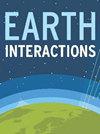全球气候分类与中全新世和末次冰期极大气候的比较,包括新增的干旱信息和一个超热带类型
IF 1.1
4区 地球科学
Q3 GEOSCIENCES, MULTIDISCIPLINARY
引用次数: 0
摘要
气候分类为气候可视化提供了关于一般植被类型的推断。目前广泛使用的是Köppen热类和干旱类分类系统,但加强气候变化检测的选择仍然存在。在这项研究中,我将温度和干旱信息纳入所有气候类别以隔离气候变化,增加了一个超热带类别以更好地检测热带地区的变暖和干燥,并为简化应用开发了一个温度变量的一致热类别规则集,但保持了主要的Köppen热类别。我将现在的气候与6000年前进行了比较(ka;中全新世)和22 ka(末次盛冰期)。生长日数> 0°C是模拟热分类最有效的变量。基于生长日数的气候分类与86%的Köppen热分类相匹配。当前气候与中全新世和末次盛冰期的分类分别占80%和23%,在当前气候下,干燥条件向热带和超热带类型转移。这一分类有助于我们对全球环境变化的理解,表明超热带类别在6 ka以来经历了最大的面积变化,在22 ka以来经历了第二大面积变化,并且在这两个间隔中干旱类别的百分比增加最大。增加的具有干旱信息的超热带气候类别在气候变化下对相关气候类别的增暖和干燥提供了敏感的检测。本文章由计算机程序翻译,如有差异,请以英文原文为准。
Global Climate Classification and Comparison to Mid-Holocene and Last Glacial Maximum Climates, with Added Aridity Information and a Hypertropical Class
Climate classifications supply climate visualization with inference about general vegetation types. The Köppen classification system of thermal classes and an arid class is widely used, but options are available to strengthen climate change detection. For this study, I incorporated temperature and aridity information into all climate classes to isolate climate change, added a hypertropical class to better detect warming and drying in tropical zones, and developed a consistent ruleset of thermal classes with one temperature variable for streamlined application, yet maintained primary Köppen thermal classes. I compared climate currently to 6000 years ago (ka; Mid-Holocene) and 22 ka (Last Glacial Maximum) worldwide. Growing degree days > 0 °C was the most efficient variable for modeling thermal classes. Climate classes based on growing degree days matched 86% of Köppen thermal classes. Current climate shared 80% and 23% of class assignments with the Mid-Holocene and Last Glacial Maximum, respectively, with dry conditions shifting to the tropical and hypertropical classes under current climate. Contributing to our understanding of global environmental change, this classification demonstrated that the hypertropical class experienced the greatest change in area since 6 ka and the second greatest change in area since 22 ka, and the greatest increase in percentage arid classes during both intervals. The added hypertropical class with aridity information delivered sensitive detection of warming and drying for relevant climate classes under climate change.
求助全文
通过发布文献求助,成功后即可免费获取论文全文。
去求助
来源期刊

Earth Interactions
地学-地球科学综合
CiteScore
2.70
自引率
5.00%
发文量
16
审稿时长
>12 weeks
期刊介绍:
Publishes research on the interactions among the atmosphere, hydrosphere, biosphere, cryosphere, and lithosphere, including, but not limited to, research on human impacts, such as land cover change, irrigation, dams/reservoirs, urbanization, pollution, and landslides. Earth Interactions is a joint publication of the American Meteorological Society, American Geophysical Union, and American Association of Geographers.
 求助内容:
求助内容: 应助结果提醒方式:
应助结果提醒方式:


